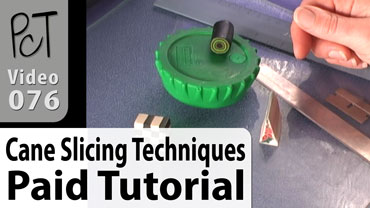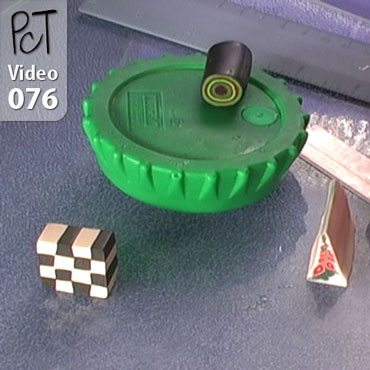Vol-006-3 Cane Slicing Techniques PcT Tutorial (Intro)
Video #076: How to slice your polymer clay canes with little to no distortion — Making bead jewelry with less waste:
More...
** This post is an introduction to one of our paid tutorials.
Getting a nice clay cane slice to use on your next polyclay jewelry making project can sometimes be trickier than it looks. Here’s a few tips and tricks that will help you perfect the technique.
Keep your polymer clay cane chilled. A firm, cool cane is easier to slice than a soft and warm one. Frozen gel or ice packs can be handy for conveniently lowering the temperature of your canework right in your craft studio.
Use a sharp tissue blade or razor blade to cut your canes. A dull clay knife will cause the whole cane to become misshapen and distorted. It will also cause the image to smear inside the slice if the blade is not sharp enough. Read this helpful post on how to sharpen dull cutting knives: Slicing Polymer Clay Canes
Look from up above and straight down when cutting your cane, so that you can see the whole cut. If you are looking from only the front or at a funny angle, the slices will be uneven.
Square canes and triangle canes cut with less distortion than a round cane does. Try turning your canes after each cut, so the distorted sides get evened out. You can also regularly reshape the cane before cutting another slice.
Cutting perfect polymer clay cane slices is such an important jewelry bead making technique to learn and master. The more nice slices you can get from your canework, the more beads, pendants and ultimately the more polymer clay jewelry you can make from them! As Martha would say, “It’s a good thing!"
ADDENDUM: Unfortunately, this Vol-006-3 tutorial is no longer available for purchase. However, the button below, will take you to our Polymer Clay Tutor Store, where there is a wide variety of other premium tutorials that you can choose from...
Shareable Images



Want to chat about today’s post? That’s what the comment section below is for. Scroll Down… We’d love to hear from you!
Or... if you would like to request a topic for a future post, here is the link to do that… PcT Suggestion Box


I made a slicer for myself similar to the simple slicer. I found it OK, but still didn’t slice like I wanted. I did find the solution – practice! I had a ball of clay that I sliced every day, several times a day. I went from nearly 0 good slices to almost all good slices, about 35 slices per block. I calculate I made well over 1000 slices before I was happy.
Once I slice my cane into pieces and I place the pieces on the clay bead, it becomes distorted when I roll the bead. How do I prevent this?
Thanks!
I’ll try and do a video on this Rochelle, because it is a common problem.
Hi Cindy, I live in South Australia and love your information tutorials. I have a query, I have been reading about cane cutters and the one I seem to like is the “precise a slice ” ? by polyzine.
I am wondering what you would recommend and off course I would need to be able to purchase this from Australia.
Hi Janeen, the only slicer that I have tried so far (besides clay blades and razors) is the Simple Slicer. I did a video on it a while ago if you want to check it out. I am sure that Lee Ann Armstrong (the inventor) would probably ship it to Australia, though I don’t know how expensive that would be. Maybe someone else will have more information that would help you?
Hi Cindy,
Wondering if you can tell me what I’m doing wrong. I want to transfer my canes unto a clay sheet but when I go to smooth the sheet out in the pasta machine the cane becomes disfigured. Maybe you could show a short video how to correct this problem.
Thank you,
Pat
I have already done a tutorial on that some time ago Pat. Here’s a link if you’re interested in finding out more:
Use Cane Slices To Make Pattern Backgrounds
.
I recently read that using a very little ArmorAll on the blade helped keep the blade from ‘catching’ on the clay. I tried it and it really worked for me. I used so little that you couldn’t see it, but it still worked.
Thank you Jamie! That’s a great tip! Use it myself sometimes when I have a soft cane. Just forgot to mention it. Thanks for the reminder!
I have always found that wiping the blade with an alcohol pad between slices, keeps them clear and the images sharp. It also seems to help the blade go through the clay a bit easier too. Just my 2 cents worth. Hope it helps.
XOXO Jamie
Thank you Donna for your comments! Sometimes it is best to have the best tools… sometimes, making do with what you have makes the most sense. I’m just passing on things that make sense to me. I’m glad the ideas work for you!
Never even thought about keeping something like
this to keep the clay cool. You have so many ideas
that are really low budgeted and something that most of
us have access to.That is the reason I got so frustrated
at some of the sites because my budget does not always
allow me to go out and spend $25.00 on one tool to try and
see if it will work for me.
Thank You,
Thank You,
Donna
You’re talking about the Able Cane Slicer Marianne. That kind of slicer is for really large canes used for background sheets etc. The types of canes I’ll be teaching you are way, way smaller and that kind of slicer won’t work for them.
The blade you’ll need for slicing the small canes is just a regular polymer clay blade which is more like $8 for two which is a lot less expensive!
Although the Able Cane Slicer is a good product, you probably won’t be needing it at this time.
Cindy Lietz’s last blog post..Slicing Fimo Nail Art Canes | Sculpey Polymer Clay Cake Toppers
I just saw a new tool for slicing the canes. It ran $95 US. But the idea which I saw done other ways than using the tool is to two “things” on either side of the cane leaving just what you want to cut off sticking up. Then pulling the knife through the clay keeping it resting on the sides so that the cut is even.
I hope you can picture what I am trying to say. I also hope that I gave a tip that someone else could use. I hate to be absorbing all the great hints and not giving back.
Do you have any tips and tricks on slicing polymer clay canes that you would like to share with us all? It’s always open mic time here at beadsandbeading.com :-)
Cindy’s last post..Faux Amber Jewelry – Polymer Clay Books – Victoria Hughes